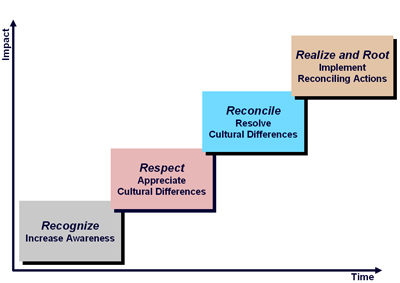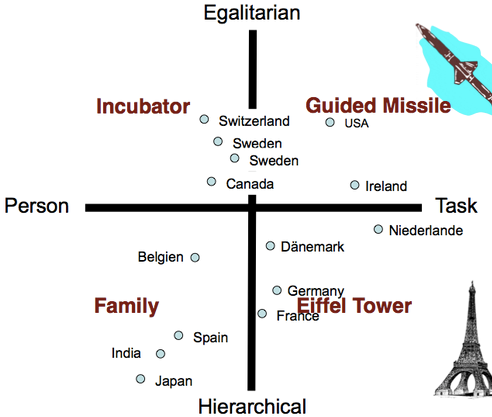In previous lessons we learned about the Hofstede and the effects of what we learn as children through our environment and how they affect how we are today and how we interact with other cultures. There are some interesting theories and practices about how to identify different cultures and how to engage and interact with them in order to achieve results. s’ dimensions of national culture and the relationship between organizational culture helps us to understand how we can’t easily change the way we may react to difference and conflict they are embedded in our unconscious; suggesting that the need to be cognoscente of how to potentially “unlearn” things in order to be successful in dealing with foreign cultures.
Fons Trompenaars is an organizational theorist and author. He and Charles Hampden-Turner were co- authors of the Trompenaars’ model of national cultural differences. Through their simple approach below in Fig 1.1, they help people in organizations understand the business value of understanding cultural differences and how to integrate them into a common purpose. They suggest that learning to recognize cultural differences, respect those differences and how to reconcile the cultural differences will help people to realize the full potential of a diverse organization.
One of the crucial underpinnings of how to do be successful in communication across organizational cultures is to realize the fundamental gaps in between these cultures. Rather than trying to decode “why” they do it, which is something that we typically try to accomplish in order to justify our own assumptions; Trompenaars and Hampden-Turner suggest that it’s more important to learn what affect our beliefs have on a culture in order to understand how to communicate and interact in such a way that you realize who you’re talking to before it’s too late.
Trompenaars and Hampden-Turner have suggested that there are four corporate culture models that can help to identify and clarify emerging organizational structures and is based on two specific dimensions – people vs. tasks and the egalitarian vs. hierarchical nature of the organization. Once again to use this effectively in communications one should study how each model can affect the way you interact and help you to avoid cultural gaffes that could prove to be detrimental to your business by allowing your own cultural beliefs to get in the way of the message. The cultural models are based on the data collected and defined by the seven key dimensions or what they call “dilemmas”. In the second edition of their book “Riding the Waves of Culture” they presented the basic types of corporate culture and how to interpret the intercultural relations.(See Figure 1.2) While I will not get into each of the dimensions of culture it’s important to recognize the basis for their data and how it helps to define the 4 different models.
The first model is called the Guided Missile. It describes companies that are managed mostly by objectives and that nothing can stand in the way. It also employs matrix management structure with balanced score cards. It gives the individual a great sense of ownership and potential satisfaction of a “win”. On the down side it can foster the pursuit of separate agendas and stressful targets and matrix management structure may work for some let’s say in the Netherlands and US but not for Italians or Parisians. People who want to communicate effectively with organizations that exhibit this behavior need to think tactically and align themselves with project goals. They shouldn’t lose sight of the big picture and they must think realistically about setting expectations. Change is typically embraced as tasks and reporting structure is constantly evolving.
Second is the Eiffel Tower and is likened to typical hardened bureaucracy where the infrastructure’s power is directly related to the importance (and/of) the position. Task and accomplishment outweigh the concerns for relationship and adherence to the rules and recognition of hierarchy are extremely important. Strong and effective, these company cultures are typical in France and Germany. The downside of this corporate culture was evident when Volvo and Renault car companies attempted to merger. Volvo sent their most senior staff to get the job done and because the Swedish counterparts were treated as upper management by the French engineers instead of collaborators the deal fell apart. This could have been easily avoided had the research been done to understand the different communication necessary to make this successful.
Familial cultures, evident in South America, India and the Far East and employs a respect not only for family but for anyone that has a deep roots in their successes. Managers tend to make decisions not only on their bosses recommendations but also on others who have influenced their careers and whom they honor. It’s built on reputation. Someone that is familiar with this culture stresses loyalty and seldom expresses disloyalty as they are frequently rewarded not necessarily for job performance but remaining loyal to their management. When communicating with this cultural group one needs to be able to communicate using examples rather than by instruction, interweaving in stories and celebration creating high context.
Finally the incubator model which is the most revolutionary of the models deals with self expression. This culture is the most egalitarian style of management and is often a very loose structure with ideation being a key performance indicator. Companies in Silicon Valley, like Google use this approach. They reward on merits of thinking about the next best idea and are typically composed of Gen X and Gen Y employees. Remember that low-synergy cultures tend to be highly individualistic, which can lead to more creativity and freedom of expression (Redmond, 2014). To talk to these folks, it’s imperative that you don’t BS them. You need to tell it like it is or don’t say anything at all. Although this cultural model is great for ideas, there is a downside to this methodology. If you have ever been in a room with these people and been lucky enough to be the main focus of communication; you probably called it “herding cats”.
The research provided by Trompenaars and Hampden-Turner (1998) suggests that when two cultures blend, they will have to figure out ways to manage the disparate perspectives and self-organize to develop synergistic solutions which allows global businesses to communicate and compete better. Stated another way, it’s imperative to find a key operational model that creates synergies between the groups in order to meet the challenges and opportunities that a multicultural workplace presents. It’s necessary to collaborate and have cultural alignment. Multinational changes are happening at such a rapid rate as companies look to be more efficient and reduce overall costs and a failure to understand the social, political and cultural issues will prevent growth, learning and overall synergy.
References
Pennsylvania State University. (2014). OLEAD 497B: Lesson 6: Cultural Synergy pg. 4 Retrieved at: https://cms.psu.edu
Schmidt, W., Conaway, R., Easton, S., Wardrope, W., (2007) Communicating Globally. Chapter 3: The Concept of Cultural Synergy and the Global Organization. Sage Publications.
Trompenaars Hampden-Turner. (2014). Website: About: Retrieved at: http://www2.thtconsulting.com/about/#about-approach
Wright, M., (2007). Cultural Barriers to Internal Communications Retrieved from: http://www.simply-communicate.com/news/cultural-barriers-internal-communications-0
Figures 1.1 and 1.2 reprinted from Trompenaars Hampden-Turner. (2014). Website: About: Retrieved at: http://www2.thtconsulting.com/about/#about-approach
Figures 1.3 reprinted from Schultz (Date n.a.) Quizlet Website on Management Retrieved at: http://quizlet.com/12500879/info




Leave a Reply
You must be logged in to post a comment.